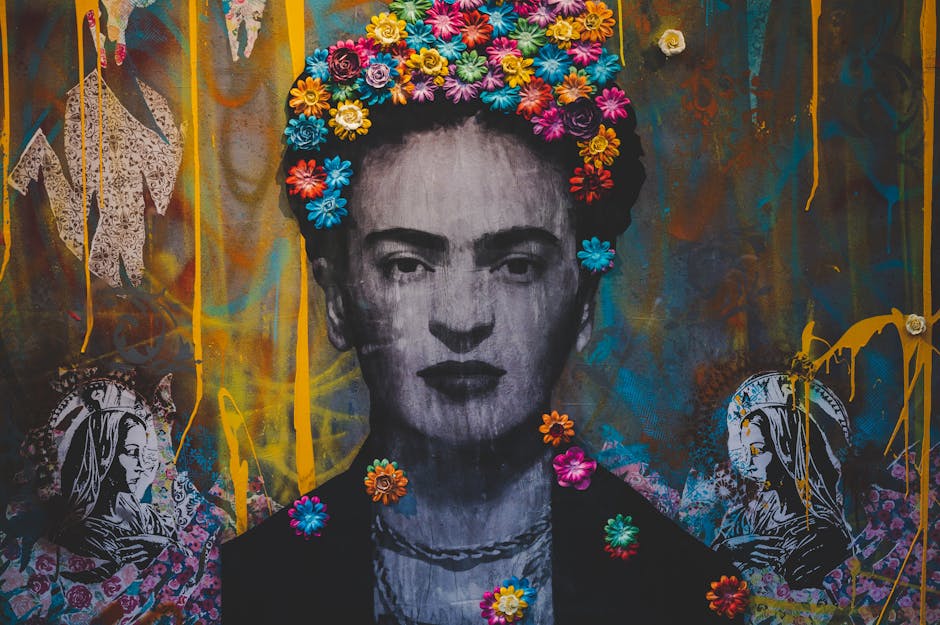Frida Kahlo's art offers a glimpse into her life, marked by physical and emotional trials. Her work, particularly Henry Ford Hospital, reflects her personal struggles and themes of human resilience and vulnerability. Through vivid imagery and symbolic elements, Kahlo invites us to witness her journey and perhaps find connections to our own experiences.
Background and Context
Frida Kahlo's art is a window into her tumultuous life. Born in Coyoacán, Mexico in 1907, she faced her first major trauma at 18 when a streetcar accident left her body broken. This experience birthed her art, as she began to paint while recovering.
Her relationship with Diego Rivera was both a tempest and a sanctuary. They married in 1929 when Frida was 22 and Diego was 42. Their marriage was known for its passion, infidelity, and occasional clashes. Through it all, Frida's art grew more profound and personal.
In 1932, Frida suffered a miscarriage at the Henry Ford Hospital in Detroit. She processed this experience through her painting, Henry Ford Hospital. In it, Frida lies naked and bleeding on a hospital bed, adrift against an industrial Detroit backdrop. Her bed is tethered to six objects by umbilical cords, each symbolizing aspects of her experience:
- A male fetus, representing the son she would never have
- A snail, reflecting the slowness of her miscarriage
- A mechanical object, symbolizing failed medical intervention
- An anatomical model of a uterus, laying bare her damaged reproductive organs
- A pelvis model depicting her inability to carry a child
- A bruised orchid, a gift from Diego, symbolizing his support amid her despair
Each element represents a piece of Frida's broken heart. Her nakedness isn't just physical vulnerability; it's mental exposure. The six red cords bind her to these symbols of hope and despair, tying together a body that could not nurture life.
Frida's loss echoes in her other works, like My Birth and A Few Small Nips, where she explores themes of life, death, and betrayal. Each brushstroke is a testament to the fragility and resilience of the human spirit.
Symbolism and Imagery
In Henry Ford Hospital, every element is carefully placed to unravel Frida Kahlo's emotional landscape. These symbols and images are fragments of her psyche, stitched together by umbilical cords that echo themes of connection and severance.
The umbilical cords are visual manifestations of attachment and loss, linking Frida to the aspirations torn from her. The male fetus symbolizes her lost motherhood and yearning for a son. The snail, slow-moving and spiraled, introduces the element of time, embodying the agonizing pace of her miscarriage.
The pelvic bone symbolizes her damaged physicality post-accident, underscoring her body's limitations. The mechanical object represents an impersonal medical system that could not save her pregnancy. The bruised orchid, a gift from Diego, mirrors Frida's fragile emotional state and the turbulence in their marriage.
Collectively, these symbols merge into a dense weave of Frida's internal world. The umbilical cords unite these motifs, telling us that while she's connected to each symbol, she's also trapped by them. Each object sags under its own weight of meaning, yet they're all anchored to her—a reminder of her inextricable link to her suffering and loss.
Through these symbols, Kahlo compels us to see not just her suffering, but the depth of her resilience, making this work a mirror reflecting universal themes of loss, struggle, and the human spirit.
Artistic Techniques and Style
Kahlo's choice of oil on metal for Henry Ford Hospital sets it apart from many of her other works. The oil paints allowed her to achieve a vibrant, visceral quality, while the metal canvas may symbolize the hardness of her surrounding medical environment.
The influence of Surrealism is evident in the painting's dream-like, otherworldly quality. The floating bed, umbilical cords stretching to disparate objects, and desolate industrial landscape all contribute to this surreal atmosphere.
Kahlo's work also borrows elements from Naïve Art, characterized by its simplicity and directness. Her straightforward depiction of her naked, bleeding body and the almost child-like representation of objects contribute to the painting's unfiltered emotional honesty.
The composition plays a crucial role in the painting's emotional weight. Frida's vulnerable figure anchors the composition, with the stark, horizontal bed creating a visual barrier between her and the world around her. The industrial backdrop looms like an indifferent witness to her suffering.
Kahlo's use of color deepens the painting's impact. The red umbilical cords stand out against the muted tones of Frida's skin and the cold backdrop, signifying lifeblood and loss. The somber palette reflects the gravity of her experience, yet there's a stark beauty in its presentation.
These techniques converge to amplify the emotional resonance of Henry Ford Hospital. The combination of Surrealism's dream-like elements with Naïve Art's raw expression creates an immersive experience. Kahlo doesn't just depict suffering; she invites empathy and introspection, making her personal trauma a universal story about vulnerability and resilience.
Emotional and Psychological Impact
Frida Kahlo's Henry Ford Hospital explores emotional depths, both for Kahlo and viewers. For Frida, this painting was a form of catharsis, an artistic way to process her grief. Surrounded by industrial severity, her state reflects physical pain and emotional devastation.
As Frida created this work, her art became her therapy. Painting allowed her to confront her suffering, transforming anguish into a tangible form. Each brushstroke was a step toward reclaiming control over her shattered world.
The painting establishes a connection with viewers through its honesty. The stark portrayal of her naked, bleeding body evokes empathy, forcing us to grapple with human vulnerability. The cords linking Frida to symbols of her pain draw viewers into her despair, making them participants in her story of loss.
As viewers stand before Henry Ford Hospital, they become witnesses to Kahlo's emotional purging. The painting's sincerity encourages us to recognize our own vulnerabilities and understand that pain is a universal experience.
This exploration of pain transcends time and space. Modern audiences find echoes of their struggles within Kahlo's torment. The emotional landscape she maps out resonates with anyone who has experienced loss, heartbreak, or physical suffering.
The painting also invites discussions about the intersection of art and emotional health. Kahlo's use of personal trauma as inspiration showcases art's ability to transform suffering into a conduit for empathy and understanding.
Henry Ford Hospital is a journey into human experience—a passage through agony, vulnerability, and the will to forge meaning out of suffering. Frida Kahlo's art narrates her personal story while illuminating shared threads of human resilience and empathy.
Cultural and Historical Significance
Henry Ford Hospital is more than a personal expression—it's a culturally infused artifact that resonates through Mexican art and beyond. In Mexico, the interplay of personal suffering and vibrant self-expression has long been a hallmark of artistic tradition, which Kahlo encapsulates.
Frida Kahlo emerges as a beacon of Mexican identity, grappling with her indigenous heritage and feminist ideals. Her works are imbued with elements of Mexican folk art, indigenous symbolism, and surrealist influences. Her vibrant use of colors, stark yet intricate detailing, and blend of personal and cultural symbolism make the painting a keystone in Mexican art history.
When unveiled, Henry Ford Hospital intersected with a pivotal period in Mexican history. The 1930s were marked by nationalistic fervor following the Mexican Revolution. While artists like Diego Rivera created large-scale murals celebrating Mexican identity, Kahlo's intimate works offered a complementary perspective, exploring the personal as political.
Initially overshadowed by Rivera's work, Kahlo's art gained renewed attention as feminism gained momentum. Henry Ford Hospital was highlighted as a poignant depiction of personal loss and a broader commentary on the female experience. Kahlo's honesty about her reproductive struggles resonated with women's movements advocating for reproductive rights and healthcare.
Globally, Frida's work began to resonate, interweaving themes of disability, gender, and identity. Henry Ford Hospital offers a stark look at the intersections of physical disability and reproductive health, challenging viewers to recognize broader implications of her experience.
The cultural impact of Kahlo's work has been influenced by movements like #MeToo, which have recontextualized discussions around female suffering and resilience. Salma Hayek's portrayal of Kahlo in the biopic Frida broadened public awareness of Kahlo's life and work, prompting deeper discourse on artistic representation of trauma.
In modern Mexico, Kahlo has become a symbol of strength, complexity, and uncompromising artistry. Henry Ford Hospital lives on in collective memory—an enduring conversation piece bridging past and present discussions about art's role in articulating marginalized experiences.
Frida Kahlo's Henry Ford Hospital encapsulates her indomitable spirit, the cultural vibrancy of Mexican art, and ongoing struggles for recognition among marginalized communities. Its impact confirms Kahlo's place not just as an artist but as a cultural matriarch whose legacy urges us to find strength in vulnerability.

Henry Ford Hospital stands as a powerful testament to Frida Kahlo's ability to transform personal suffering into a universal story. Her art captures the depth of her pain while highlighting human resilience. This painting remains a compelling reminder of Kahlo's enduring impact, resonating with anyone who has faced life's challenges.






















